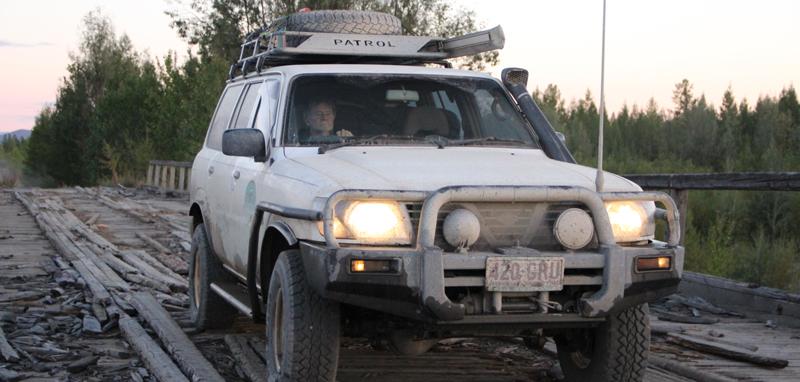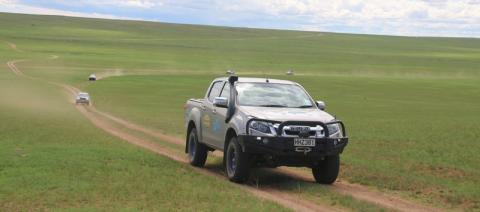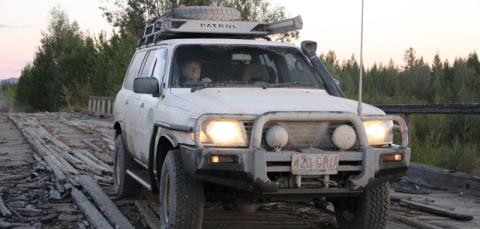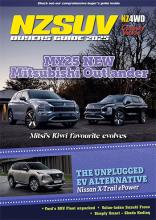Keen adventurer Robin Dicey didn’t have to be asked twice when the opportunity to join a group of fellow Kiwis on an epic overland trip from Bangkok to Magadan presented itself.
Story by Robin Dicey Photos by Grant and Tricia Short
My brother and I had hired a local guide and gone fishing. Mongolia is famous for extraordinarily big trout-like fish called Taimen. Someone we knew had caught one a bit over a metre long and we fancied our chances – but first we had to get to the spot.
The going there was easy; the fishing wasn’t that great although we did manage to catch a tiddler, and we were treated to an extraordinary lunch of a freshly killed marmot cooked by way of having its insides dragged out and replaced with hot rocks! The meat was incredibly tough but the ‘soup’ was delicious!
Now to get back to camp. It had started to rain and the way in had been over grass and an occasional track. The tyres I had were not at all suitable for this work, so the 75 km back was very interesting. OK along the flatter bits, but a real slip and slide operation both up and down the hillier bits. Took three hours out and nearly five hours back.
That evening over a few beers in the ger, with a fire going as it was cold at the altitude we were at, Bob, one of the others in our little group, suggested a trip north south. We were at that stage about a quarter way through an east-west traverse of Asia and Europe having started in Vladivostok with a plan to get to London about two months later. This was a Rally Tours operation run by Greg Paul.
A worthy challenge
Bob’s idea was to drive from Singapore to Magadan – about 20,000 km. Given that there is only one road into or out of Magadan, and that this is the Road of Bones, it sounded like a worthy challenge.
In the end the plan was changed to a start in Bangkok instead of Singapore and it was game on.
Greg could not join us for the first part of the trip so his old friend Grant Short led a group of five vehicles for the first three quarters of the journey. Three Land Cruisers, a Nissan Patrol and our Isuzu D-Max ute. The first challenge was getting the vehicles out of the clutches of the port authorities.
The guy representing our interests worked for a local forwarding agent and did not seem to be all that effective; so we missed a day and had a late start out of Bangkok on a Friday evening during rush hour.
It was pelting down. The Monday was going to be a holiday so everyone was getting out of the city. And Bangkok had two more elements which require a mention in passing: it receives more visitors a year than any other city on earth – 26 million people visit there every year – and the number of motorbikes and scooters is just staggering. Helmets are supposed to be worn but are seldom seen. And the number of folk/bike is also surprising; we saw two-up, three-up and five-up, but never a four-up!
Not a good start
The late start also meant an extra-long first leg as we had missed our first hotel. Not a good way to begin a tour with a Cannonball Run first up and a double trip thrown in as well. That first town was Chai Rat with a totally forgettable hotel. My wife Margie was starting to question her sanity and I was full of explanations that things were only going to get better: this after I had only managed to persuade her to come with me after much begging and promising.
The next day was a border crossing at Mae Sot, leaving Thailand and into Myanmar. Our attention was diverted from the petty officialdom and endless paperwork as there was a Lions v All Blacks rugby test being played and one of the group had a phone around which we were all crowding to hear what was going on.
In recent years Myanmar has had an unfortunate time: it has been run by a group of pillaging generals for a long time, and they have made some very strange off-the-cuff laws. Immediately after crossing the border we came across one of these.
A number of years ago the general in charge of roads and transport decided that Myanmar would throw off the shackles of its past colonial history and from a certain day would cease driving on the left – which is what Thailand does – and start to drive on the right. So just after the border there are some road markings which guide drivers entering Myanmar to the right hand and those leaving Myanmar back into the left as they go back into Thailand.
Some added spice
The colonial past has not been totally expunged however. Many of the older roads still have milestones next to them, and interestingly these also carry furlong numbering as well; so every 220 yards there is a milestone with the distance from Yangon (used to be Rangoon) in miles with a furlong noted underneath it. Just to add a bit of spice there are occasional kilometre indicators as well.
Given our inattention at the border, along with all the hassle of trying to get Australian, Kiwi, British and Russian registered vehicles through the bureaucratic quagmire, we were going to be driving well into the night. And the roads were appalling. And the driving was dreadful. To dip lights for oncoming traffic had obviously not been taught to local drivers. The seal was badly broken and the edges were often potholes of some depth. None of the countless villages we went through had any lights at all and the houses were extraordinarily close to the road. There were people walking right next to the road which given the bright lights of oncoming traffic often meant that just for safety one had to come to a complete stop. There were bullock carts on the road, and these had no lighting whatsoever.
Big mistake
At one point I decided that I could see just well enough to overtake a truck. It meant driving out into the verge. Big mistake. The innocuous looking puddle was about a metre deep and the ute almost came to a stop getting through it.
Then down into Yangon itself. A few years ago there had been an assassination attempt on one of the generals by a pillion passenger on a motorbike. So the generals banned motorbikes from Yangon. At one level this was OK as bikes are an ever-present hazard, but the upshot of this diktat was that the car traffic is staggering. And the general answer to this is to simply keep going – traffic lights are largely seen as suggestions, not something to be obeyed.
Two further aspects of Myanmar stand out – the endless numbers of bullock carts on all roads: we were really excited when we saw our first couple, but after ten days and thousands of carts later we hardly noticed them.
Then there was the capital, Naypitaw. The generals decided that Yangon was not a good enough city to be a capital – probably too much traffic… so they built this most amazing bling sort of city out in the middle of nowhere.
About 40 huge hotels – all the big names – with an occupancy rate of about one percent, and the most stupendous buildings to house their parliament, with a 22 lane highway going past it. And to cap it all off the place is virtually deserted.
So there we were, five foreign vehicles with 22 lanes all to ourselves with not another vehicle in sight. So obviously we misbehaved; we were all connected by radio, so we tried formation manoeuvres just for the hell of it. We were spotted by the Minister of Tourism who sent the police out to invite us into the government buildings. Great fun…
Side trip to Laos
From Myanmar it was then back into Thailand. We planned to go direct from Myanmar into China but there were some border security issues which prevented this, so we went back into Thailand and up into Laos.
Narrow windy roads where we had to use decidedly dodgy techniques to overtake on the endless hills and corners: when the lead vehicle managed an overtaking manoeuvre it would call through the next in line and so on. Often we were essentially passing totally blind relying on the ‘clear ahead’ call from the vehicle immediately ahead.
The roads were very mixed. One bad habit in Laos was that repair crews saw no need to warn drivers of road works. So one would be getting along OK when there could be a patch of construction, often heralded by an enormous drop from the seal on to an extraordinarily rough gravel surface. On one of these patches I dropped into e deep pothole and I believe a small stone got into the gap between the brake pad and the rotor. This tore the pad surface clean off and for the next 600+ km one pad was simply steel on steel, with the most horrendous noise every time I used the brakes.
Our exit from Laos into China had bit of a twist: between the border posts there was bit of no man’s land for a few km which neither country wanted to look after. The result was a stretch of road so bad that the potholes needed great care to get around or sometimes through. Along came an impatient driver in a Toyota Highlander who could not be bothered with our slow speed. He passed me – I was tail-end Charlie – and went nose first into an enormous water-filled pothole.
The water and mud came up over the roof. He emerged at 45⁰ only to enter the next pothole; at which point with a horrible noise the vehicle bellied with its front wheels spinning in one puddle and the back wheels spinning in another. Sadly we did not have the time to help him – but he had driven like a pork chop.
Great roads
The roads in China were simply stupendously excellent – nothing further from a 4WD experience could be imagined. We were almost always on expressways and these need to be seen to be believed: huge tunnels – some 15 or more km long – (these freaked me out a bit as I am a bit claustrophobic) and even some which were made into a spiral. Then out of the tunnels and on to huge bridges. The views, particularly in the southern areas which were not obscured by fog, were spectacular.
One little irony I enjoyed was that as we crossed the Tropic of Cancer we noted that the main crop being grown was tobacco.
In the tiniest imaginable little repair shop specialising in disc brake repairs I managed to get the brakes fixed – two new rotors, a complete set of pads and the work done fixing it all: total bill – a shade under NZ$80.00! And the whole street came to take photos of the first foreign plated vehicle most of them had seen!
To no roads
And so into Mongolia. Where there are often no roads at all. The road to the northern border was designated highway AO 503 but consists of nothing other than a track through the endless plains. If one doesn’t much like the track the grassland next to the ‘road’ can used – and we often resorted to this: but there is the ever-present issue of empty vodka bottles lying in the grass. One driver managed to hit two at the same time, which caused a bit of a problem.
The Mongolian government is getting road building assistance from China; we had a fair bit of rain when we were there which meant that we had to go bush for long stretches in very difficult conditions. Endless mud and pretty scary potholes; miles and miles of 4WD and still there were times when we wondered if we would get through.
Last leg
Finally, into the last defining leg of the trip; up to Yakutsk and on to the Road of Bones. At Skorovodino we were joined by another group of five vehicles brought across from Vladivostok. Now we were 10, a pretty large and clumsy number for the convoy.
The first bit of the road up to Yakutsk was 90 percent an extraordinarily dusty, or if it rained, an extraordinarily muddy gravel road. By and large the surface was OK, but 200 km from Yakutsk the little bumper bracket over which the U-bolts go to hold the rear axle in place on the D-Max shattered and went AWOL. This made handling a little challenging but we had to keep the speed up as there was a ferry to catch to get to the city.
Yakustk is on the wrong side of the huge Lena river. A number of ferries keep the city and the road in touch during the summer. The Lena flows due north into the Laptev Sea (which I had never heard of before!) and is big enough at Yakutsk for ocean-going ships to dock – the sea is 1450 km from the city. When we got there the temperature was close to 40degC; in the winter it gets down to minus 60degC, a range of 100 degrees! In the winter when the Lena is under metres of ice a complete roading system is put up on the ice: traffic lights and black painted road markings – the lot!
Our tour then went a little awry: Greg decided to take our Russian guide on a recce to see if the Summer Road, a particularly difficult stretch of the Road of Bones, was drivable. In a somewhat strange decision not only did he take our only Russian speaker with him, he also went without another vehicle as back-up.
So the last and most difficult part of the trip started without Greg – and finished without him as well, as he got stuck in a bog for five days. We were led by Grant again, who did a marvellous job under really difficult conditions.
A remarkable achievement
From Yakutsk the true nature of the Road of Bones came to the fore. There were very few smaller vehicles – the conditions were just too rough for them. Given that the road is built over a permafrost base it is a remarkable achievement for there to be a road at all. But the permafrost does have its malign influence felt all along the route: often there would be a seep in the middle of the road which the heavy trucks had turned into mud. Given the distances we needed to travel each day between the towns we had to maintain a pretty hectic speed.
I had managed to bodgy together a repair to the retainer bracket in Yakutsk so all was well with the ute. Often we would be belting along at 70 or even 80 km/h only to see an enormous pothole. ABS would kick in and just before hitting the hole the brakes would come off in order to lift the nose a bit. And there were trucks which needed to be overtaken in the five metre dust – called this because that was the distance we could see.
Once again we used the call through system. Khandyga, Ust-Nera and Susuman were the three stops on this road: all fair distances apart and Ust-Nera in particular was an extraordinarily gritty and ugly little town with a hotel which was even worse.
A plague of punctures
The trip between Ust-Nera and Susuman was perhaps the most difficult: it started with a number of punctures to kick off then got even worse – for the first hour we were in a heavy mist, on a gravel road (imagine the windscreen!) and heading into the glow of a rising sun.
Punctures plagued us all day. There must have been eight or nine. It needs to be said that I had bought Mickey Thompson tyres specially for the trip and never regretted it. Ours was the only vehicle which never had a puncture – some folk had six during the trip.
A number of us had fitted tyre pressure and temperature monitoring systems and these worked really well: on a number of occasions tyres deflated slowly and the temperature built up as pressure was lost. The monitoring system alarm would go off and the tyre could be saved before it self-destructed from the heat.
And so finally into Magadan. The end-point of the Road of Bones. It has only the one road in or out, and locals seldom leave town. Our foreign plated vehicles were the subject of much scrutiny. Finally had the ute washed in one of those super-efficient Russian car washes and left it there to be shipped home.
Beaut ute
Aside from the spring bracket and the brake pad, the Isuzu D-Max never missed a beat. It was certainly bouncier than the softer Land Cruisers, but it used way less fuel than any other vehicle on the trip. They all carried spare fuel and used it; we didn’t bother. At the end of the trip we compared notes and it was apparent that while everyone else had serious issues with dust, we had absolutely none in the cabin at all.
The deck was another story and despite my best efforts it needed constant cleaning out. When I get it home, before it gets sent to the US for its next trip. I’m going to link the deck under its lid to the cabin via a tube in order to see if a little positive pressure will keep the dust out.
To read every story in the NZ4WD Annual go to Zinio.com (Dec 08) or purchase your own hard copy at the Adrenalin store.


 ,
, 

